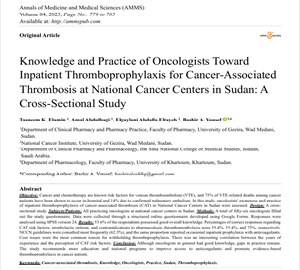Knowledge and Practice of Oncologists Toward Inpatient Thromboprophylaxis for Cancer-Associated Thrombosis at National Cancer Centers in Sudan: A Cross-Sectional Study
Authors
##plugins.themes.bootstrap3.article.main##
Abstract
Objective: Cancer and chemotherapy are known risk factors for venous thromboembolism (VTE), and 75% of VTE-related deaths among cancer patients have been shown to occur in-hospital and 14% due to confirmed pulmonary embolism. In this study, oncologists' awareness and practice of inpatient thromboprophylaxis of cancer-associated thrombosis (CAT) in National Cancer Centers in Sudan were assessed. Design: A cross-sectional study. Subjects/Patients: All practicing oncologists at national cancer centers in Sudan. Methods: A total of fifty-six oncologists filled out the study questionnaire. Data were collected through a structured online questionnaire developed using Google Forms. Responses were analysed using SPSS version 24. Results: 53.6% of the respondents possessed good overall knowledge. Percentages of correct responses regarding CAT risk factors, prophylactic options, and contraindications to pharmacologic thromboprophylaxis were 55.4%, 55.4%, and 75%, respectively. NCCN guidelines were consulted most frequently (62.5%), and the same proportion reported occasional inpatient prophylaxis with anticoagulants. Cost issues were the most common reason for withholding thromboprophylaxis. There was an interesting correlation between the years of experience and the perception of CAT risk factors. Conclusion: Although oncologists in general had good knowledge, gaps in practice remain. The study recommends more education and national programs to improve access to anticoagulants and promote evidence-based thromboprophylaxis in cancer patient.
##plugins.themes.bootstrap3.article.details##
Copyright (c) 2025 Tasneem K. Elamin, Amal Abdulbagi, Elgaylani Abdalla Eltayeb, Bashir A. Yousef

This work is licensed under a Creative Commons Attribution 4.0 International License.
Creative Commons License All articles published in Annals of Medicine and Medical Sciences are licensed under a Creative Commons Attribution 4.0 International License.
Tasneem K. Elamin, Department of Clinical Pharmacy and Pharmacy Practice, Faculty of Pharmacy, University of Gezira, Wad Medani, Sudan.
Department of Clinical Pharmacy and Pharmacy Practice, Faculty of Pharmacy, University of Gezira, Wad Medani, Sudan.
Amal Abdulbagi, Department of Clinical Pharmacy and Pharmacy Practice, Faculty of Pharmacy, University of Gezira, Wad Medani, Sudan.
Department of Clinical Pharmacy and Pharmacy Practice, Faculty of Pharmacy, University of Gezira, Wad Medani, Sudan.
Elgaylani Abdalla Eltayeb, National Cancer Institute, University of Gezira, Wad Medani, Sudan.
National Cancer Institute, University of Gezira, Wad Medani, Sudan.
Bashir A. Yousef, Department of Clinical Pharmacy and Pharmacology, Ibn Sina National College of Medical Studies, Jeddah, Saudi Arabia. Department of Pharmacology, Faculty of Pharmacy, University of Khartoum, Khartoum, Sudan.
Department of Clinical Pharmacy and Pharmacology, Ibn Sina National College of Medical Studies, Jeddah, Saudi Arabia.
Department of Pharmacology, Faculty of Pharmacy, University of Khartoum, Khartoum, Sudan.
[1] WHO (2022). Cancer. Geneva: World Health Organization, (online) available at: https://www.who.int/news-room/fact-sheets/detail/cancer. (Accessed on 3rd January 2023).
[2] Roopkumar J, Khorana AA. Risk of Thrombosis in Cancer: Clinical Factors and Role of Primary Prophylaxis. Cancer Treat Res. 2019;179:55-68. doi: 10.1007/978-3-030-20315-3_4.
[3] Labianca A, Bosetti T, Indini A, Negrini G, Labianca RF. Risk Prediction and New Prophylaxis Strategies for Thromboembolism in Cancer. Cancers (Basel). 2020;12:2070. doi: 10.3390/cancers12082070.
[4] Gervaso L, Dave H, Khorana AA. Venous and Arterial Thromboembolism in Patients with Cancer: JACC: Cardio Oncology State-of-the-Art Review. JACC Cardio Oncol. 2021;3:173-190. doi: 10.1016/j.jaccao.2021.03.001.
[5] Mendoza E, Visperas JC. Knowledge, attitude and practices on venous thromboembolism prophylaxis among internists of the University of Santo Tomas hospital. Philippine Journal of Internal Medicine. 2012;50:1-10.
[6] Nichetti F, Ligorio F, Montelatici G, Porcu L, Zattarin E, Provenzano L, et al. Risk assessment of thromboembolic events in hospitalized cancer patients. Sci Rep. 2021;11:18200. doi: 10.1038/s41598-021-97659-9.
[7] Martin KA, Cameron KA, Lyleroehr MJ, Linder JA, O'Brien M, Hirschhorn LR. Venous thromboembolism prevention in cancer care: implementation strategies to address underuse. Res Pract Thromb Haemost. 2023;7:102173. doi: 10.1016/j.rpth.2023.102173.
[8] Bayadinova JA, Sardo LA, Penton L, Jenkins S. 'Spot the CLOT': Awareness of cancer-associated thrombosis in healthcare providers. Can Oncol Nurs J. 2022;32:325-330.
[9] Almarshad F, Bandy A, Alfaiz A, Alotaibi SF, Alaklabi SA, Alotaibi YF. A Multi-center Cross-Sectional Assessment of Healthcare Professionals' Knowledge, Attitudes, and Practices Toward Thromboprophylaxis. Cureus. 2024;16:e61835. doi: 10.7759/cureus.61835.
[10] Alameri M, Sulaiman SA, Ashour A, Al-Saati MA. Knowledge and attitudes of venous thromboembolism for surgeons in two Saudi Arabian medical centers. Archives of Pharmacy Practice. 2019;10:107-111.
[11] Kiflie AM, Mersha AT, Workie MM, Admass BA, Ferede YA, Bizuneh YB. Assessment of knowledge, attitude, practice and associated factors of venous thromboembolism prophylaxis among health professionals. A cross sectional study. International Journal of Surgery Open. 2022;39:100436. doi: 10.1016/j.ijso.2021.100436.
[12] Al-Mugheed K, Bayraktar N. Knowledge, risk assessment, practices, self-efficacy, attitudes, and behaviour's towards venous thromboembolism among nurses: A systematic review. Nurs Open. 2023;10:6033-6044. doi: 10.1002/nop2.1914.
[13] Vardi M, Dagna L, Haran M, Duckit R. Attitudes towards and practice of venous thromboembolism prevention in general internal medicine wards: a multinational survey from member countries of the European Federation of Internal Medicine. Thromb Res. 2012;129:573-576. doi: 10.1016/j.thromres.2011.07.043.
[14] Gao F, Kause J. Thromboprophylaxis awareness among hospital staff. Br J Nurs. 2010;19:1175-1178. doi: 10.12968/bjon.2010.19.18.79051.
[15] Sun B, Tang X, Liang L, Tong Z. A survey of knowledge and application of mechanical thromboprophylaxis among the medical staff of intensive care units in North China. Clin Respir J. 2018;12:1591-1597. doi: 10.1111/crj.12715.
[16] Gashi YN, Elgenaid SN, Suliman HH, Abdalrahman IB. Knowledge, attitude and practice of orthopedic registrars toward prophylaxis of venous Thromboembolism”. International Journal of Current Research in Life Sciences. 2018;7:2735-2738.
[17] Martin KA, Molsberry R, Khan SS, Linder JA, Cameron KA, Benson A 3rd. Preventing venous thromboembolism in oncology practice: Use of risk assessment and anticoagulation prophylaxis. Res Pract Thromb Haemost. 2020;4:1211-1215. doi: 10.1002/rth2.12431.

